With a pleasant scent and anti-inflammatory properties, rose water and rose hydrosol are the perfect addition to homemade cosmetics. Learn several ways to make your own rose water or hydrosol and the difference between them.
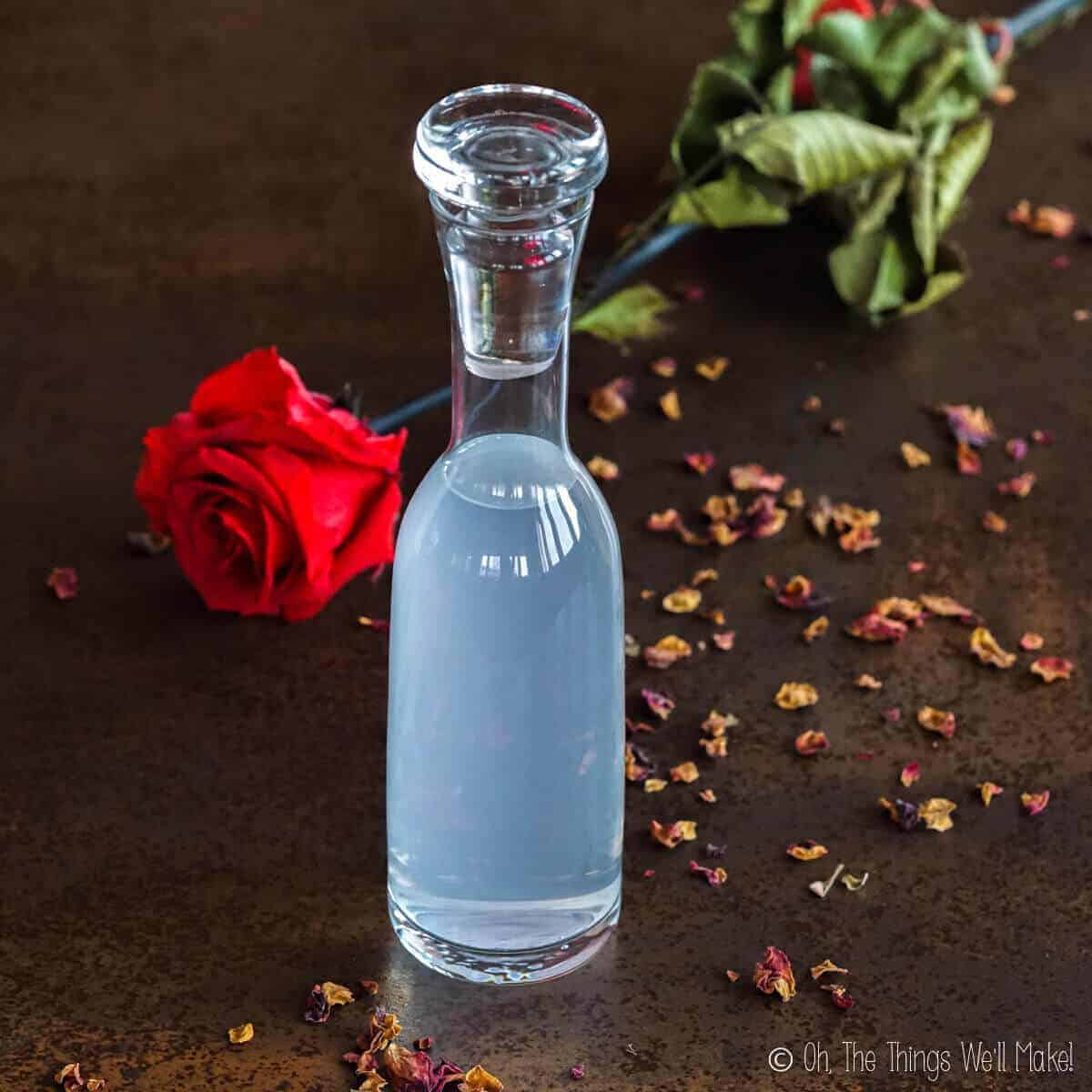
Table of contents
What is it?
The term “rose water” can refer to several different products. Some people use the terms “rose water” and “rose hydrosol” interchangeably. There are times when you can do that, but not always.
Rose water vs. rose hydrosol?
Some rose water is made by infusing rose oil, extracts, or flavorings into water. It tends to be quite fragrant and also flavorful.
Rose hydrosols, on the other hand, are made by distillation. Water vapor moves through rose petals, picking up some of the oils along the way. When the vapor is cooled, the condensation is called a rose hydrosol.
So, while you could call a rose hydrosol a type of rose water, not all rose waters will be rose hydrosols.
Edible rose water
One type of rose water can sometimes be found in the international food section of some large supermarkets. It is used for flavoring foods and is especially popular in Asia and the Middle East.
It is perfectly fine to use these sorts of rose waters for adding fragrance to your cosmetics. In fact, they tend to have a stronger scent (and flavor). As these waters can be made in different ways, make sure to read the label to see if the one you plan to use has any ingredients you want to avoid.
The one I bought to make Turkish delight has “water, rose extract, and potassium sorbate (E202)” on the label. I’ve also used it to flavor panna cotta and to make rose-flavored gummies.
It’s hard to know, exactly, what “rose extract” is, though, and how it was made. (Extracts can be made in a number of ways, using alcohol, glycerin, water, or some other solvent.)
It is normal for rose water to have some sort of preservative in it too. In this case, potassium sorbate is the preservative they chose. It’s a common choice for edible products.
Recipes
Hydrosols
Rose hydrosols are more constant. Unlike rose waters that are made of water and rose extracts, oils, or other unknown ingredients, rose hydrosols are made by distillation.
Distillation can be done at home in a variety of ways, I’ll share my experience of trying several of them below.
Benefits
Apart from adding a pleasant fragrance, rose water may also add some other desirable properties to your homemade cosmetics. It has antibacterial, antioxidant, and relaxation properties.
Rose extracts have also been shown to have analgesic and anti-inflammatory effects. That makes rose a great choice for adding to homemade lotions and moisturizers. (I used it to add a scent to my homemade moisturizer for oily, acne-prone skin.)
Unlike essential oils, that may cause a reaction for those with sensitive skin, rose water is much better tolerated by the vast majority of people. It is also safer for use in products meant for babies. (That’s why I used it to add a pleasant scent to my baby wash and shampoo recipe and also in my homemade wipes solution.)
Ways to make it
As I stated earlier, “rose water” can be made in a number of ways.
Infusion
The easiest way to make a type of “rose water” is to make an infusion. This is the method I used for my homemade rose gummy treats!
To make an infusion, you basically make a “tea” or somehow steep fresh or dried rose petals in water.
The rose petals can be placed in either hot or cool water and allowed to steep long enough to give off some of their oils, color, and fragrance to the water.
Using warm or hot water, or steeping the “tea” out in the sun, helps give off more of the essence of the rose petals more quickly. You can also hasten the process by crushing the petals to help them give off more of their oils and fragrance.
I’d suggest choosing using warm or hot water when working with dried rose petals. When working with fresh petals, I’d crush the petals and steep them in cooler water to help preserve their freshness.
The results will vary depending on the type of rose used, whether you use fresh or dried petals, and your method for steeping the flowers. Experiment to find the desired results for your particular project.
Warning
An infusion of rose petals won’t keep for very long without any added preservatives. I’d suggest making small batches and keeping it in the refrigerator for up to a week.
When using an infusion in homemade cosmetics, make sure that you filter out the rose petals thoroughly using a tightly woven cloth. Any leftover plant matter will make it more difficult to preserve your product.
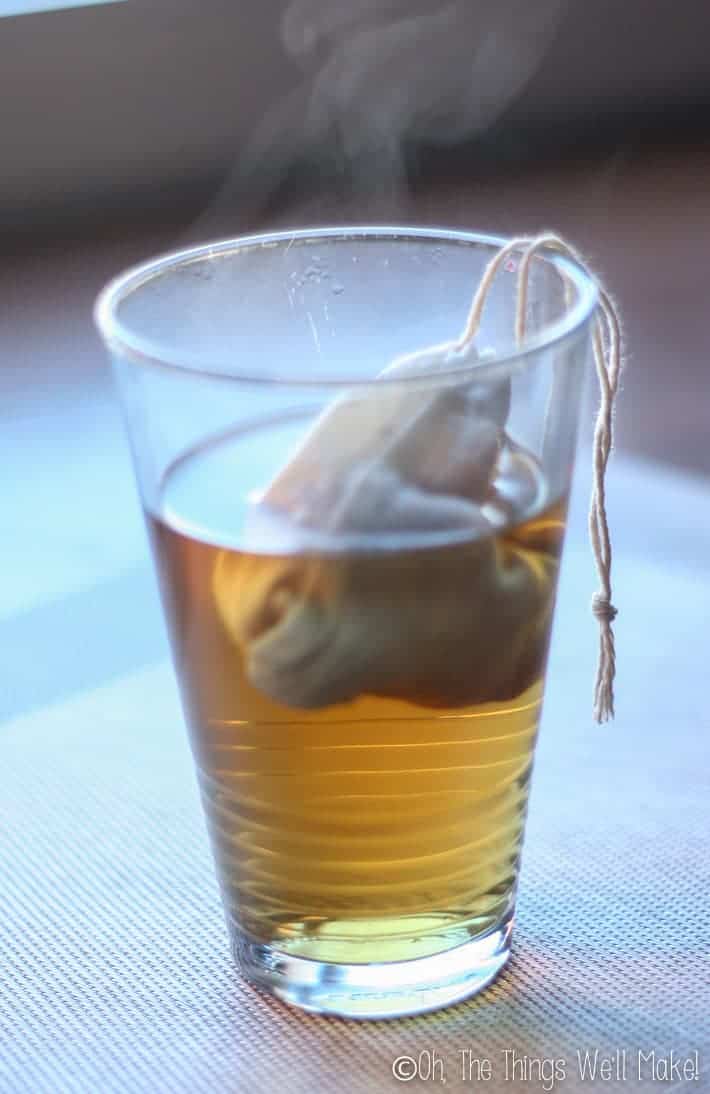
Extraction
Instead of just using water to infuse the rose petals, other more potent solvents can be used to make a rose extract. Rose extracts are then combined with water to make a different type of rose water.
Extraction using alcohol
Perhaps the most common way to make an extract is to steep plant material in alcohol. It’s how I made a homemade vanilla extract and also how I made homemade bitters.
When making extracts using alcohol, it’s best to use stronger alcohols, preferably above 40%, for more thorough extraction.
Because alcohol is a natural preservative, extracts made with alcohol can be kept for much longer than those made by infusing the same plant material in water.
After steeping the petals for several days to weeks, filter out the petals and save the rose extract. You can dilute the extract, as needed, by adding distilled water.
If you want the extract to stay self-preserving, without the need for other added preservatives, make sure to keep the alcohol percentage above 20%.
Rose glycerite
For those who wish to avoid alcohol, glycerin can also be used to make a rose extract known as a glycerite.
Just as before, allow the rose petals to steep in the glycerin for several days to weeks. When using fresh rose petals, it’s especially helpful to crush the rose petals in the glycerin to help them give off more of their properties to the glycerin.
Like alcohol, glycerin helps preserve the extract. The finished product should keep well, when left undiluted, for several months. Some people feel more comfortable adding a preservative to their glycerites, though, especially when making glycerites of fresh fruits and vegetables.
Once diluted, you’ll want to use up the mixture quickly or properly preserve it using natural preservatives. (See my guide to natural preservatives if you aren’t sure about it.)
Adding rose oil to water
Another way to make a type of rose water is to add rose essential oil to water.
Because water and oil don’t normally mix, you’ll need some sort of solubilizer to get this to work.
The most commonly found solubilizer that you can use is alcohol. To dilute rose oil in water, you’d first dilute it in a high percentage of alcohol. (For the best solubilization, the percentage should be over 95%.)
Once the oil has been incorporated into the alcohol, distilled water can be added. The final mixture should ideally stay above 20% alcohol to keep the floral water preserved without the need to add other preservatives.
Making a hydrosol
Rose hydrosols are a great addition to homemade cosmetics. It takes a bit more effort to make rose hydrosols, but they are still quite easy to make and they keep much better than infused rose waters.
Unlike infusions and extractions of rose petals, distillation won’t result in a colorful product. Instead, a pure colorless liquid will be obtained.
Rather than steeping the rose petals in a solvent, water vapor is sent up through them. When the water vapor is later condensed, the resulting water will have rose oil with it. When making large enough quantities, you may see some rose essential oil floating on top of the liquid. The liquid is your homemade rose hydrosol.
Use a still
The most “professional” way of making a rose hydrosol is to use a still meant for distillation.
Here in Spain, the most commonly found stills are called “alambiques” (alembics) and they are hand made from copper. I bought a copper still years ago in the hopes of making my own essential oils from herbs I was growing at home. Unfortunately, I chose a size that was a bit too small (around 3 liters) to actually obtain a worthwhile amount of essential oil.
Luckily, floral waters are just as useful for making cosmetics. I have used the still to make everything from lavender and rosemary waters to homemade witch hazel and rose hydrosol.
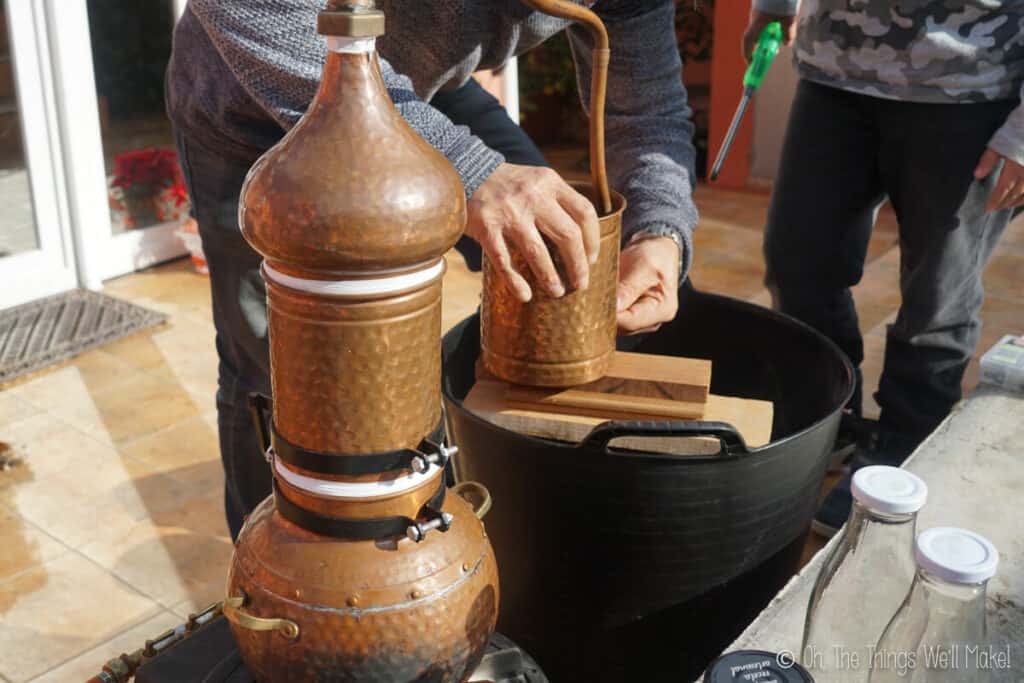
Water is placed in the lower section 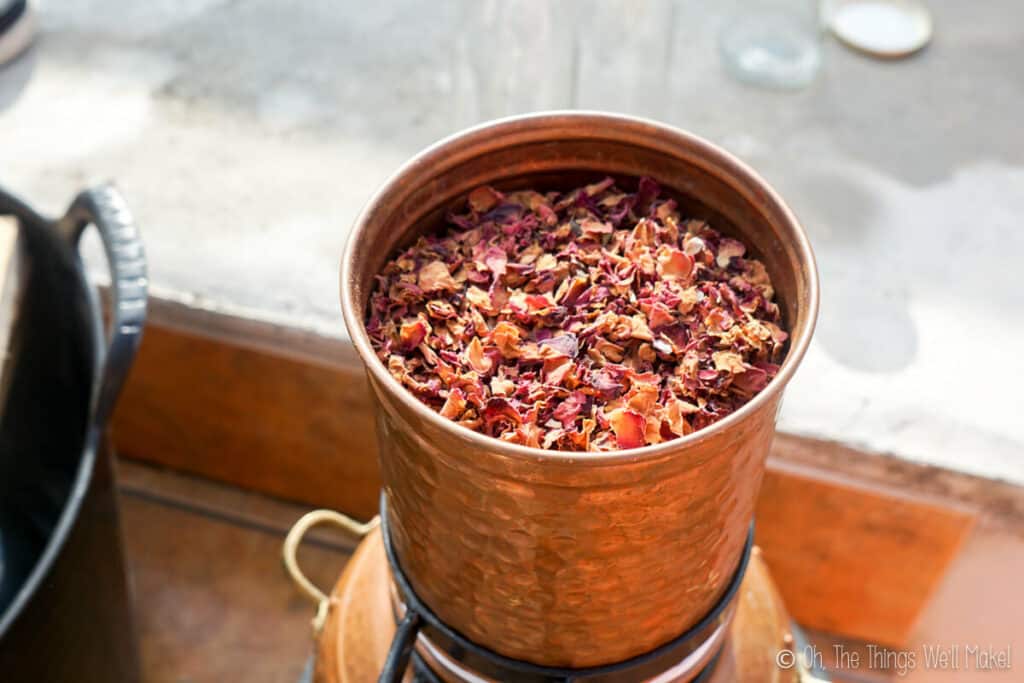
Rose petals are placed in the middle section. 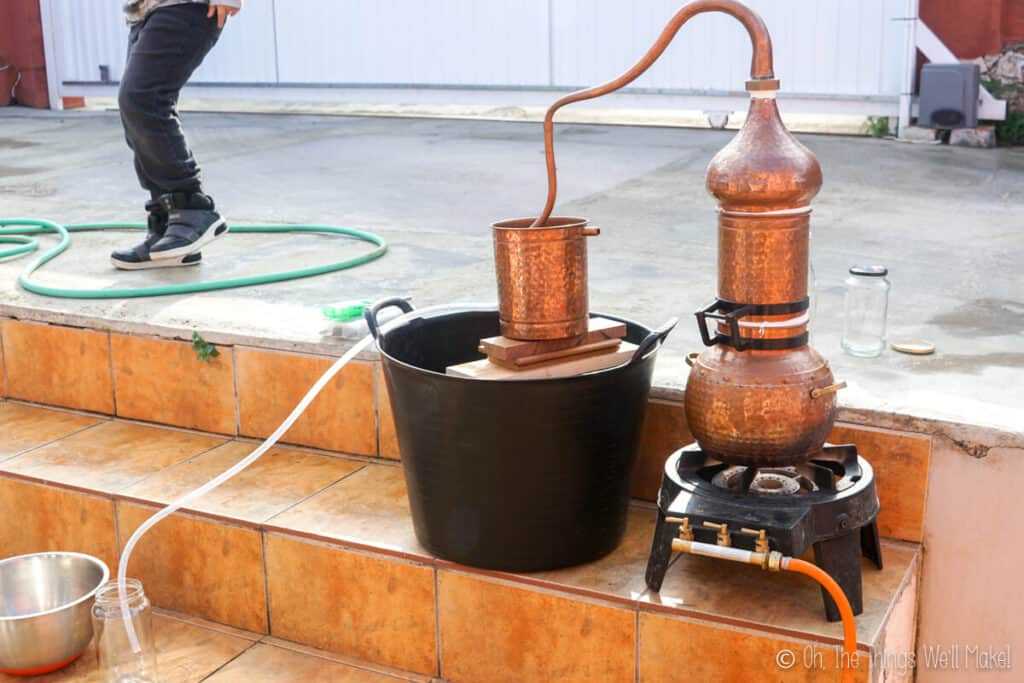
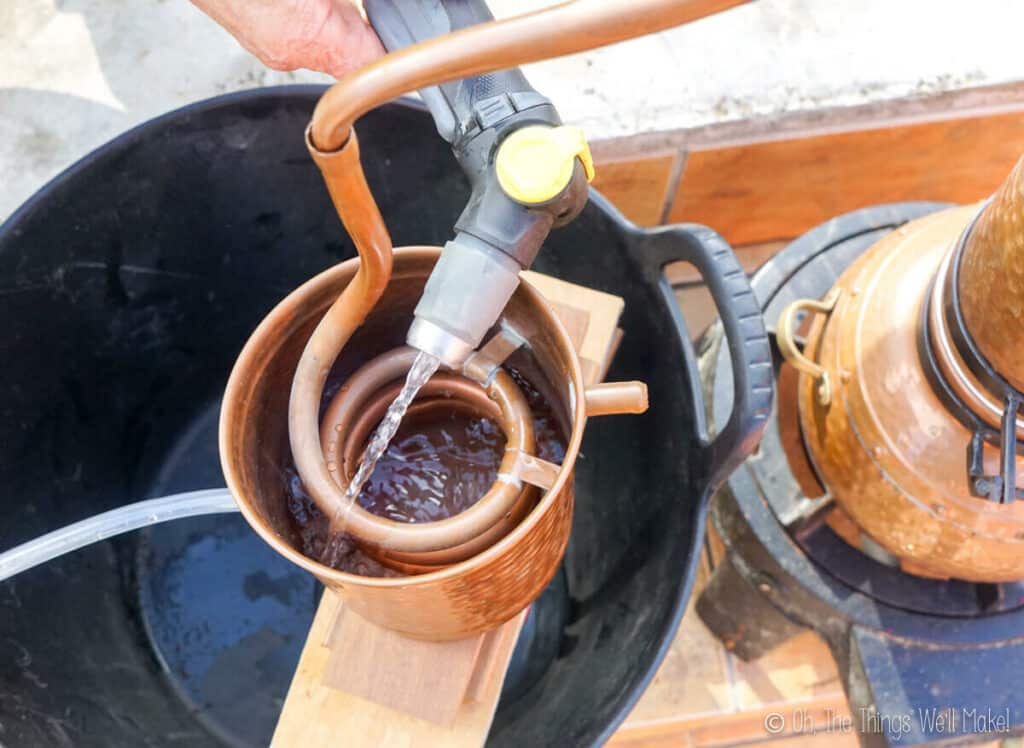
Cool water around the coil helps condense the vapor. 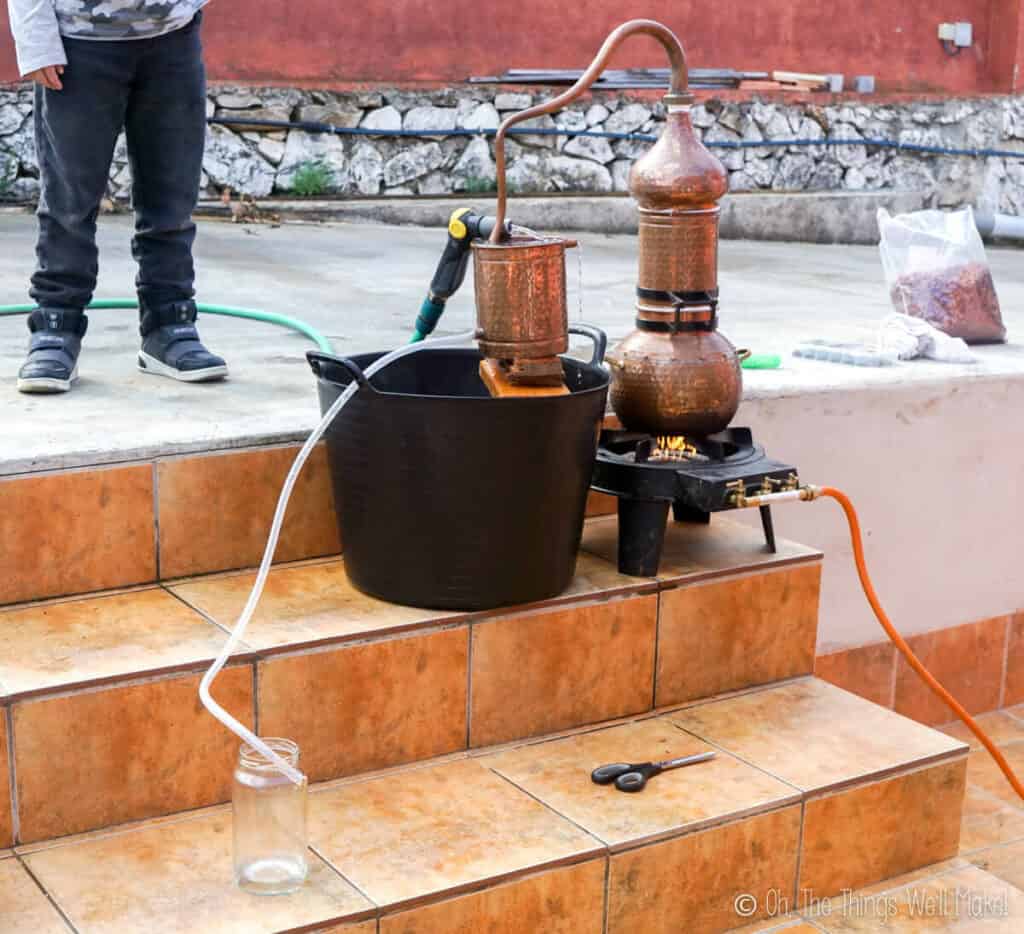
Copper still setup
Setting it up
To make a rose hydrosol using a still, the rose petals are placed either in the bottom of the still with the water or are placed above some sort of grill that rests above the water level.
My copper still has an extra middle section that can be used when distilling plant material. The plant material is placed in that middle section after filling the bottom portion with water. The middle section has holes in the bottom to allow the vapor to rise through the plant material on its way up to the top of the still.
At the top, the vapor exits a tube that makes a turn to the side and then moves down to a coiled copper tubing. The coiled tubing fits into a small copper cylinder that can hold ice or cold water to help condense the water vapor more quickly.
We used a hose to keep cool water circulating around the coils as they tend to heat up any ice water around them quickly.
Finally, there is an area at the end of the copper coil where you can attach silicone tubing. That tubing is used to bring the homemade hydrosol to a glass bottle or jar for storage.
Use a water distiller
Another easier option, but another that requires specialized equipment, is to make the hydrosol with a water distiller.
I already had a water distiller because I use a lot of distilled water for making homemade soaps and cosmetics.
Water and rose petals can be placed in the bottom of the distiller. It can then be run as usual and the resulting distilled water will actually be a rose hydrosol.
You can also add water to the bottom of the distiller and then place the petals in a strainer above the water. This keeps the petals from steeping directly in the hot water. In the photo above, you can see that I used a silicone strainer to keep the rose petals elevated above the water.
Use a pot with a lid
For those who don’t have a still or a water distiller, a large pot can also be used to make a rose hydrosol.
Again, with this method, there are several ways to do it. You can place the rose petals and water directly in the bottom of the pan together or you can fill the pan with water and then place the petals on some sort of grill above, keeping them out of the water.
For separating the water and rose petals, I used a pasta pan that has a special strainer insert for easily removing cooked pasta from the cooking water. (It can also be used to steam foods in the upper insert.)
I prefer that second method. I have tried it both ways and the scent of the final water made with the petals suspended above the water was cleaner than the one made with the petals steeped directly in the water.
Regardless of which method you choose, you’ll want to add a heat-resistant bowl to the middle of the area where you have the rose petals. The bowl will be collecting the rose distillation.
Once you have the bowl in place, cover the pan. Rather than place the lid on the pan in the normal way, though, you’ll want to flip it upside down. The idea is to have the rounded shape of the lid pointing downward. Any vapor that condenses on the lid will move down towards the center and fall into the bowl below.
To ensure that the water vapor condenses and falls into the bowl, place some ice into the inverted lid. The water vapor will rise and then cool upon reaching the ice cold lid. That helps the water condense into drops and fall back down into the clean bowl.
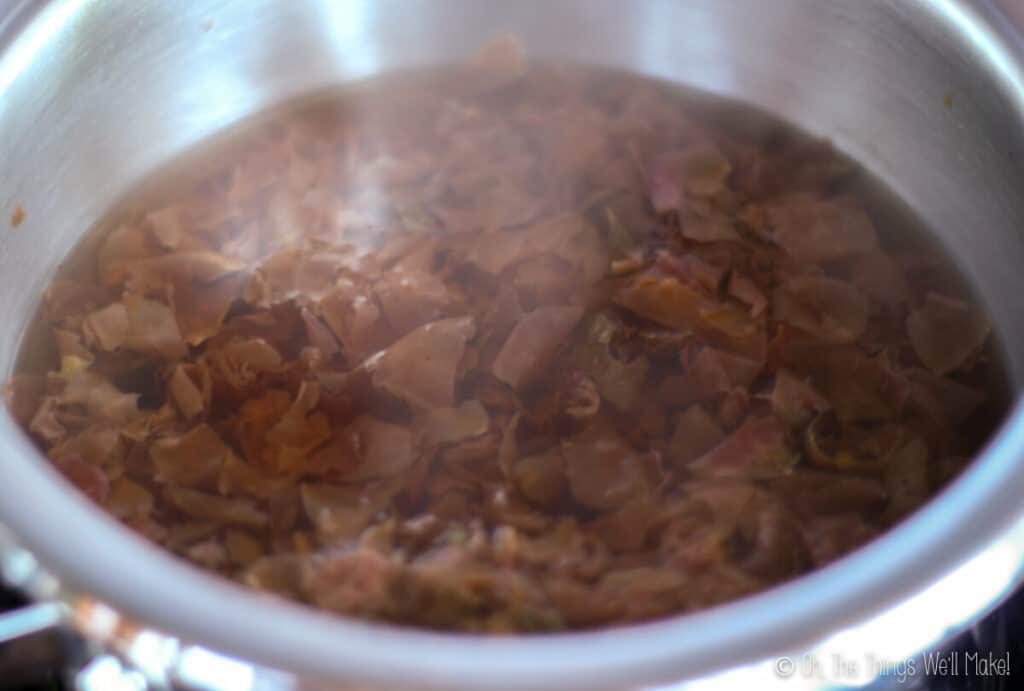
Adding rose petals directly to water in a pan 
Adding a bowl to the pasta insert of a pan 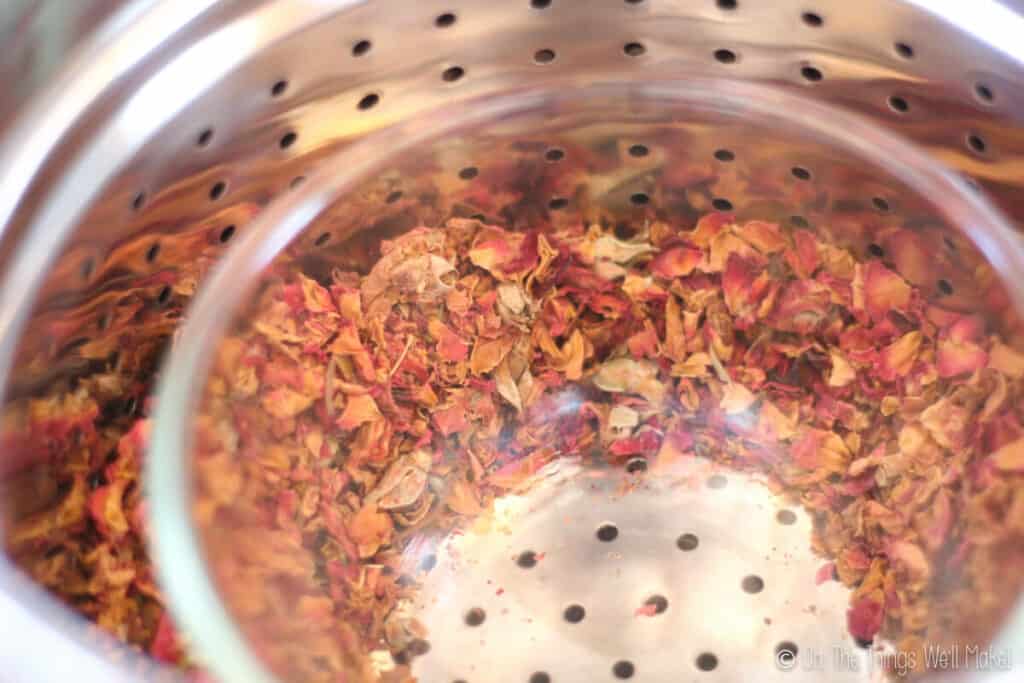
Adding rose petals around the bowl in a paste insert of a pan 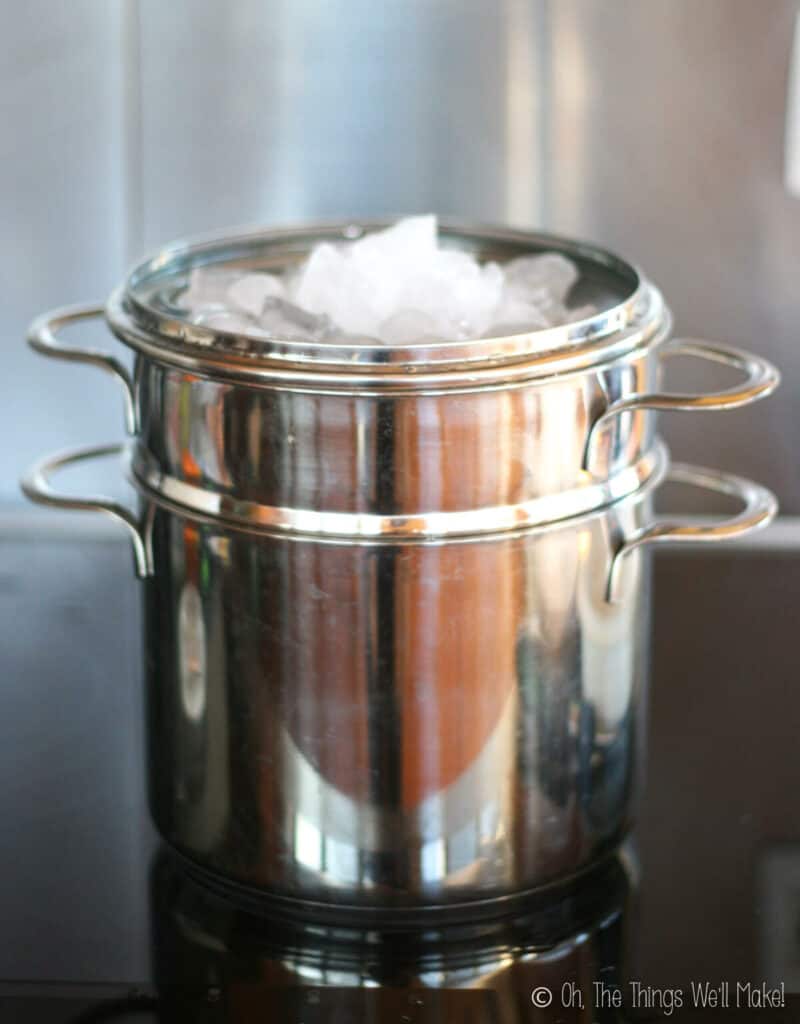
Adding ice to the inverted lid above the rose petals. 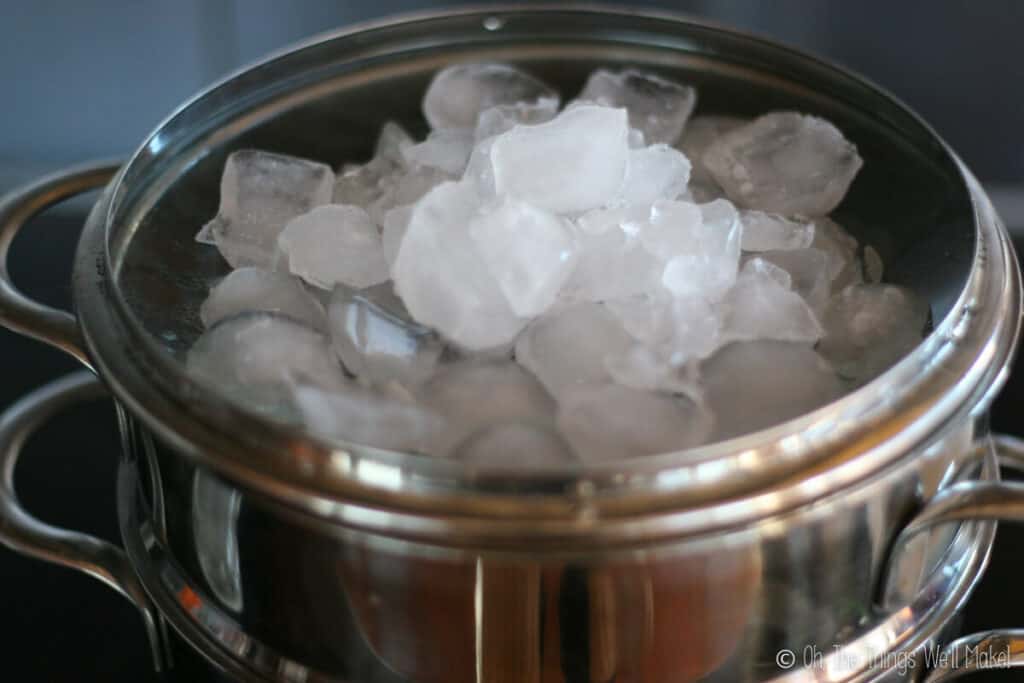
Closeup of ice in the inverted lid 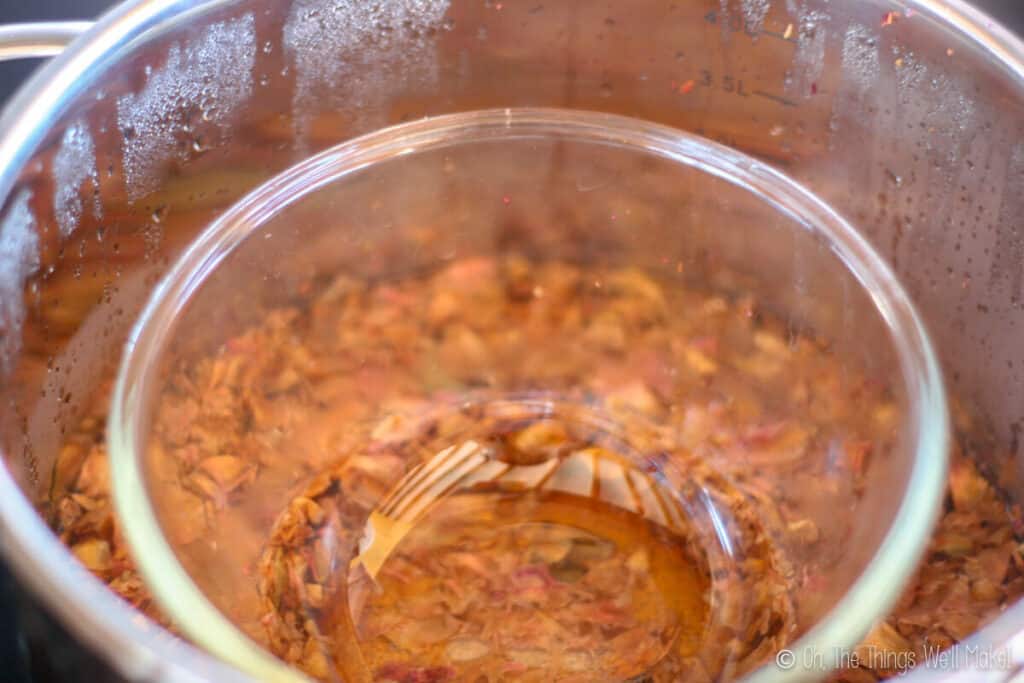
The petals after the distillation process
After boiling the water for a while, check on how things are going. You don’t need to evaporate away all of the water. (Doing so could give your rose water a burnt scent.)
Warning
If your lid is made of glass, consider using another similar-sized lid for this project. The difference in temperature between the ice above and the water vapor below could cause the glass to crack!
Storage
Finished hydrosols should be stored in a cool, dark place. If stored in the fridge, you can extend their shelf life even more.
There are several other ways to extend a hydrosol’s shelf life.
- Reduce contact with air by keeping bottles as full as possible. (You can switch to smaller bottles as you use up the liquid.) Similarly, keep the bottles tightly sealed when not in use.
- Use dark glass bottles to keep light from getting to them. (The disadvantage to using dark bottles is that it is more difficult to see any changes that could alert you to the hydrosol going bad.)
- Use bottles that have been previously sanitized with alcohol. Also, avoid contaminating the liquid inside by dipping into it.
Hydrosols can keep for several months in a cool, dark pantry or up to a year or two in the fridge.
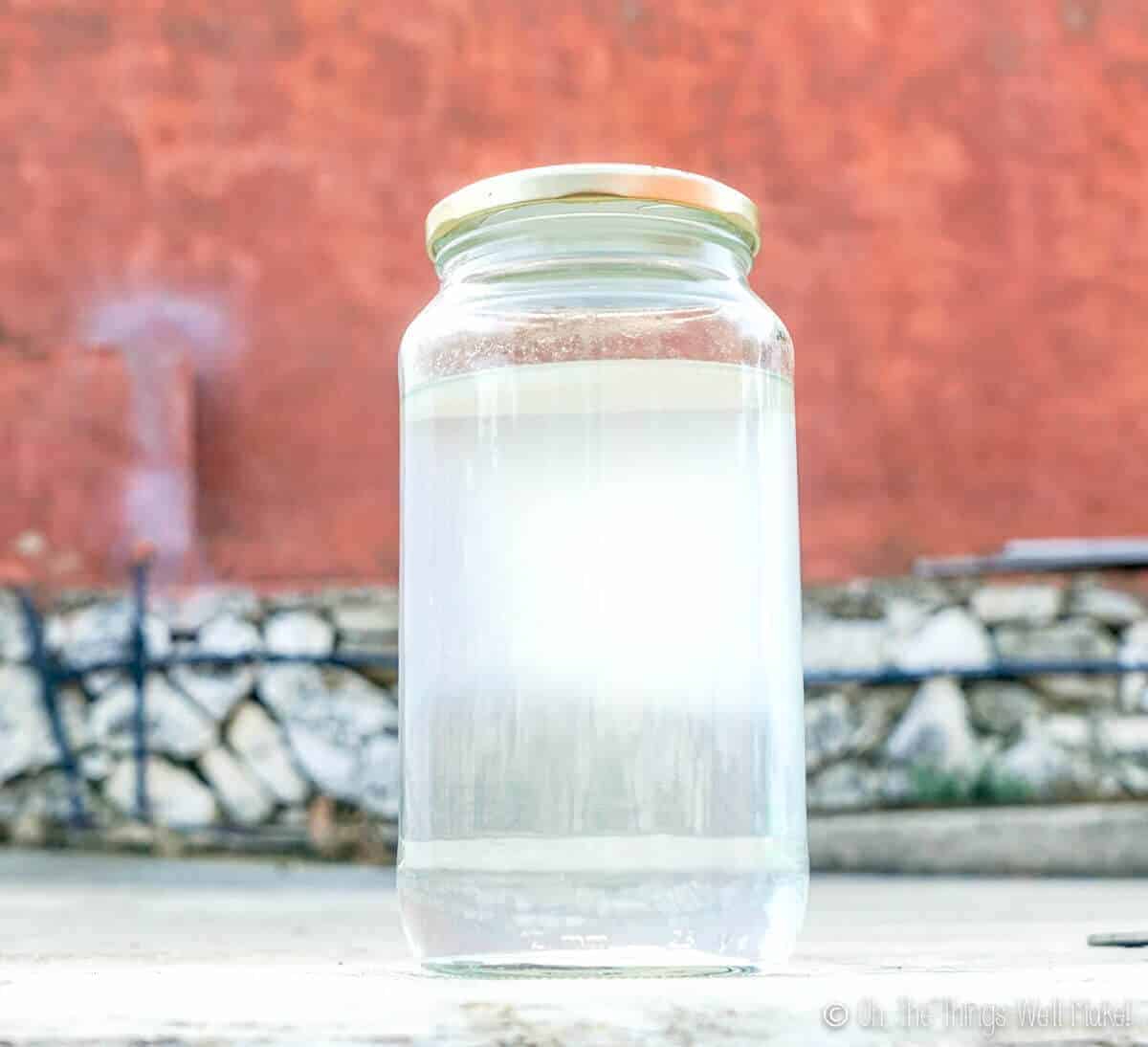
Do hydrosols need preservatives?
This is actually a bit of a controversial subject.
Some people do not preserve their hydrosols and claim they do not need it. The theory is that the hydrosols come out of the still sterile. If the storage bottle has been properly sanitized and the hydrosol goes directly into that bottle which is immediately closed, the risk of microbial growth of the liquid in the bottle is low.
I’ve also seen the claim that the oils that are suspended in the water have a small enough particle size that they don’t pose a risk for microbial growth like other water and oil mixes do. (Plus, many essential oils, which is “essentially” what is suspended in the water, have antimicrobial properties of their own.)
Once you open the bottle, the liquid is potentially exposed to microbes that could lead to either mold or bacterial growth. While mold growth can normally be seen, bacterial growth tends to be invisible.
That’s why I think it’s best to err on the side of caution, especially when making this sort of product at home. Most of us aren’t going to spend money to do microbial testing on our products.
You don’t necessarily need to add potent preservatives in large quantities, though. This is a lower risk product.
Many suppliers sell their hydrosols with a preservative added, but not all do. If you look to see what preservatives they are using, citric acid and potassium sorbate are often used.
If using citric acid alone, aim for using around 0,1%. If using both potassium sorbate (antifungal) and citric acid, aim for around .15% potassium sorbate plus .05% citric acid.
Keep in mind that these low percentages are for preserving the finished hydrosols for long-term storage. When using the hydrosols for making homemade cosmetics, the finished product should be using a more potent preservative.
You can get more ideas for preserving homemade cosmetics from my beginner’s guide to natural preservatives.
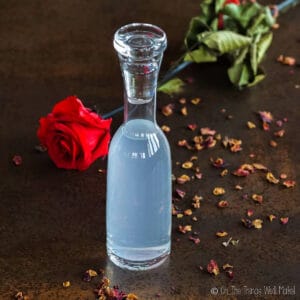
Rose Hydrosol
Equiment
- large pot
Materials
- rose petals fresh or dried
- water
Instructions
Using a Still
- Fill the bottom of the still with water.
- Place the rose petals either in the bottom of the still with the water or pour them over some sort of grill that will allow the vapor to pass through the petals, but that will keep them above the water level. (Some stills have an extra section made for distilling plant material in that way.)
- Make sure any seams between the various components of the still are sealed in some way so that the water vapor doesn't escape. (Some people use clays, others use plumbers' tapes.)
- Find a way to cool the coiled tubing of the still. Normally this section is in some sort of container that can be filled with ice water. You can also run a continuous flow of cool water over the tubing once you see water vapor forming. (Save the water used for watering plants!)
- Heat the water in the bottom section using either a gas or electric stove. (Or use whatever else you may have on hand. Some stills are electric and just need to be turned on.)
- As the water boils, the vapor will move up through the rose petals to the tubing at the top of the still. At the top, the vapor normally exits and makes a turn to the side. It then moves down to the coiled tubing.
- As soon as you see signs of water vapor forming, add ice or cool water around the tubing to help condense the rose hydrosol.
- As the water condenses, collect it in a clean storage jar.
- Keep running the still until most of the water has evaporated from the bottom of the still or until you have enough rose water.
Using the stovetop
- Place water in the bottom of a large pot.
- Add the rose petals either directly in the water or over some sort of strainer that will allow water vapor to rise up through the petals without them actually touching the water below. (You can use a pasta or steamer insert for this.)
- Make room in the center of the rose petals for a medium-sized clean, heat-safe bowl and place it there. (If you are adding the petals directly to the water, place the bowl over something that will keep it from touching the bottom of the pan. This helps prevent evaporating our finished rose water.)
- Add an upside-down lid to the top of the pot. (Avoid using glass to prevent stress fractures of the glass due to extreme temperature differences.)
- Heat the pot to boiling.
- Fill the inverted lid with ice.
- As the water boils, the water vapor should go up to the lid and condense there due to the coldness from the ice. It should then drip down into the bowl in the center of the pan below.
- Occasionally remove the condensed rose water to prevent it from evaporating away and to make room for more. Continue until most of the water below has evaporated, or until you have made enough. (Leave some to keep the petals from burning as that will affect the fragrance of your finished water.)
Notes
If you love roses, why not try making these:
Rose Petal Bath Fizzies
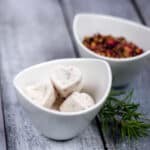
 Español
Español
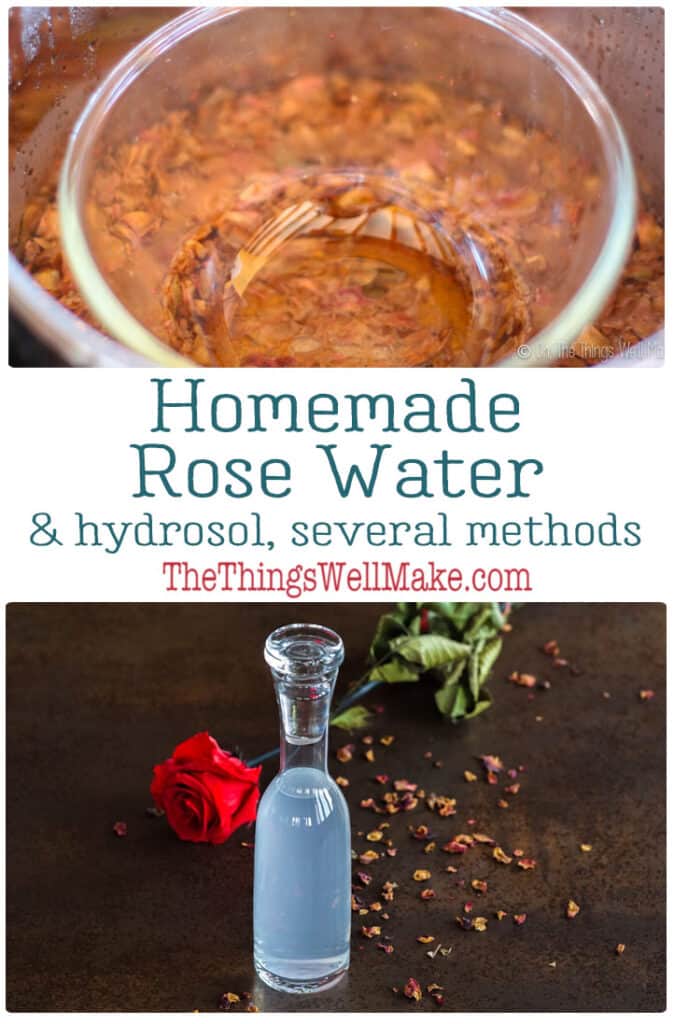
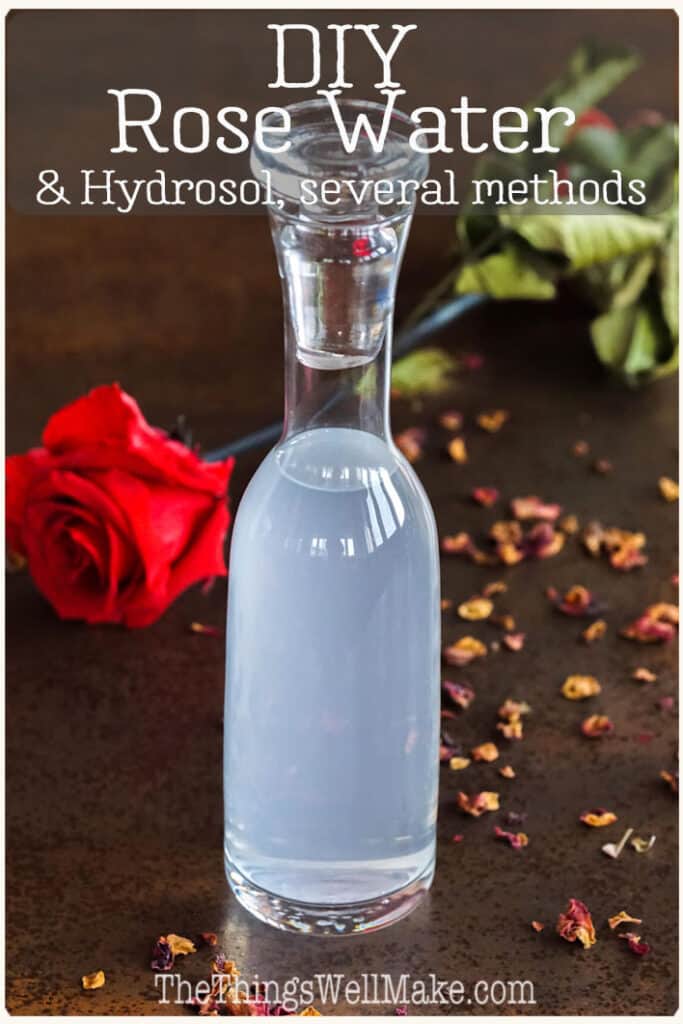
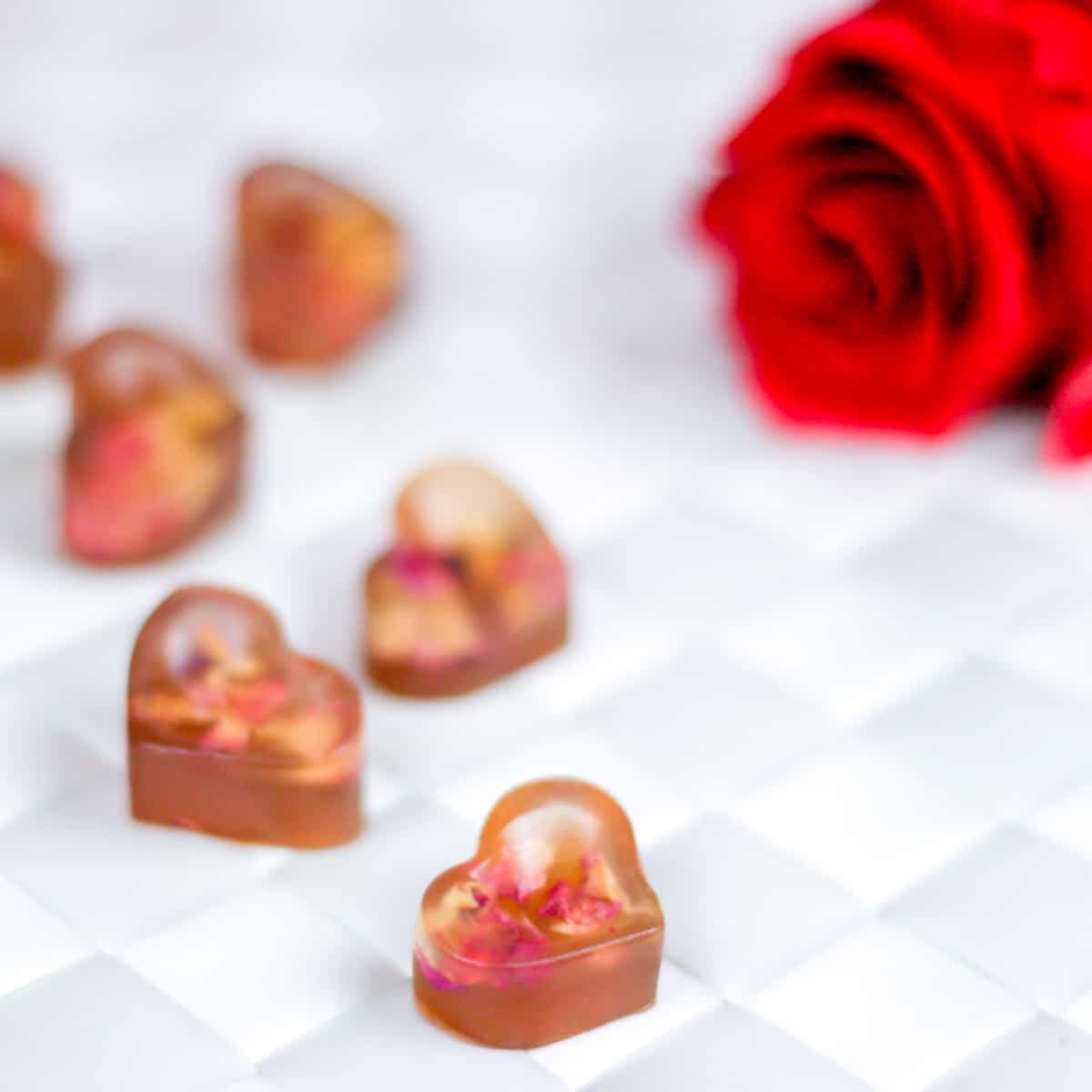
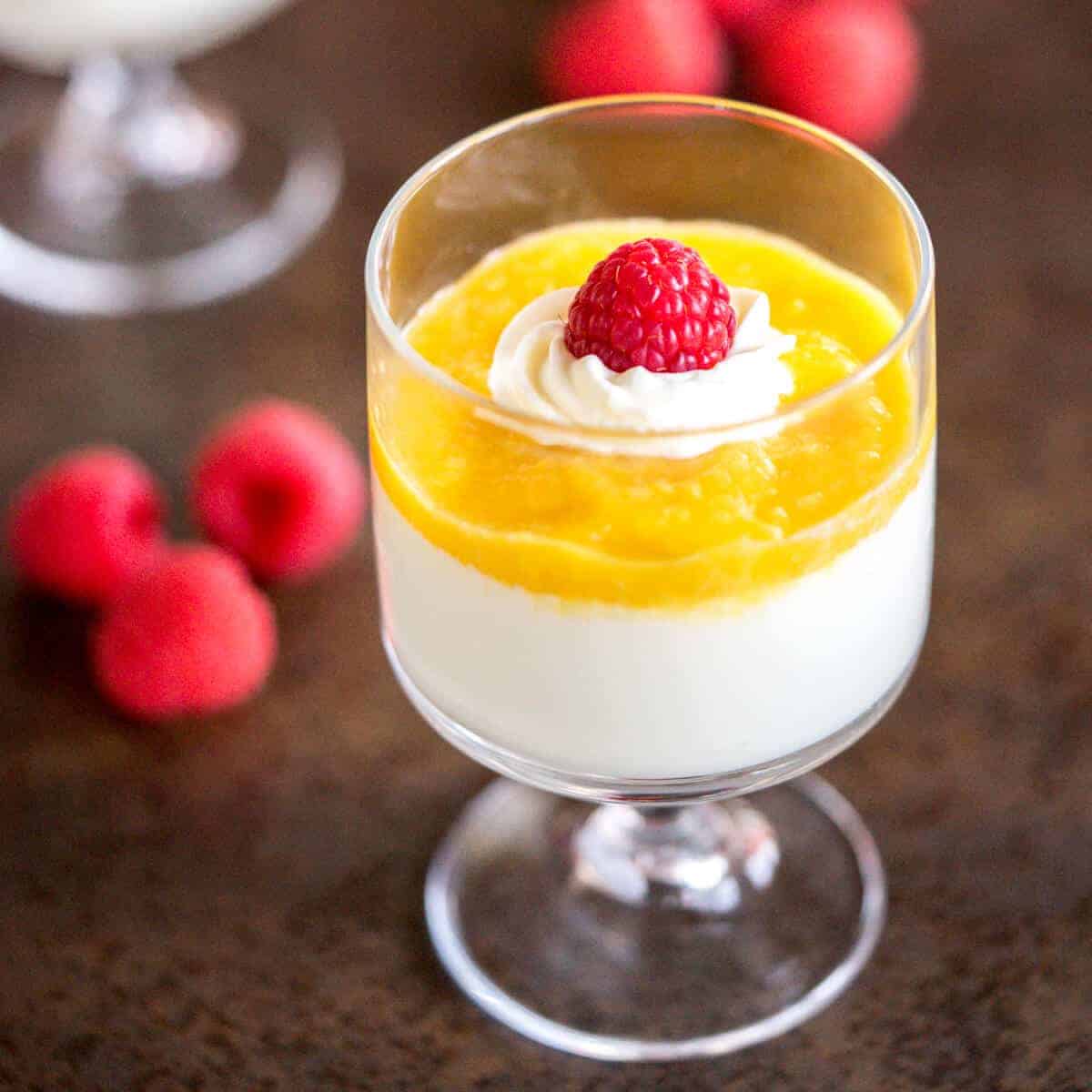
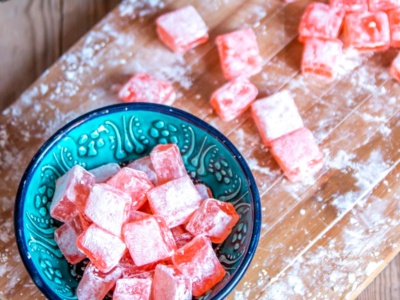
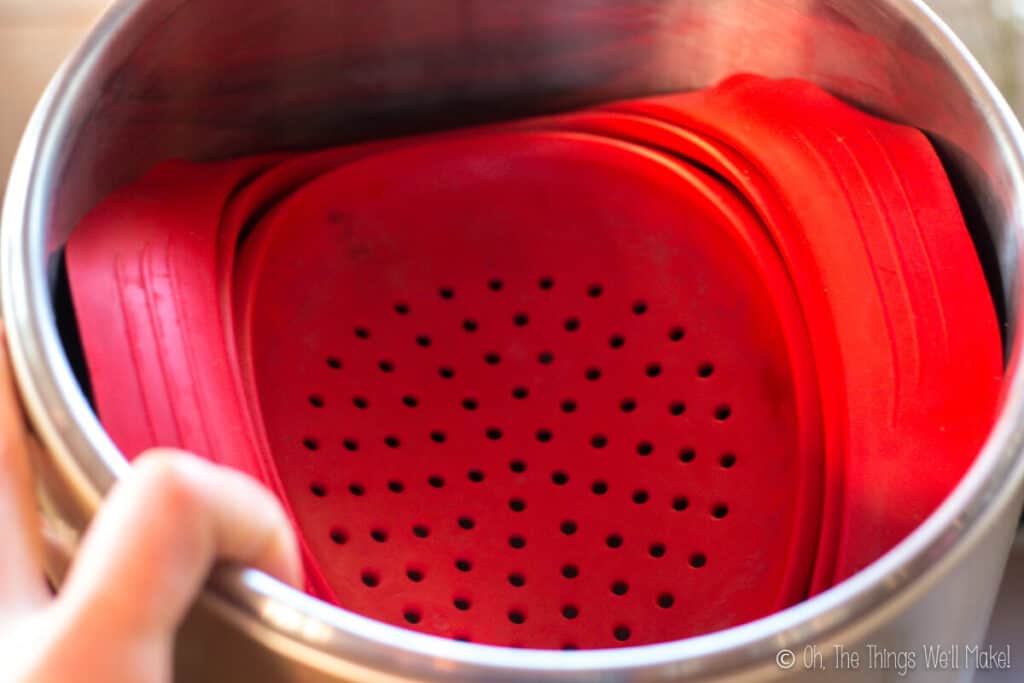
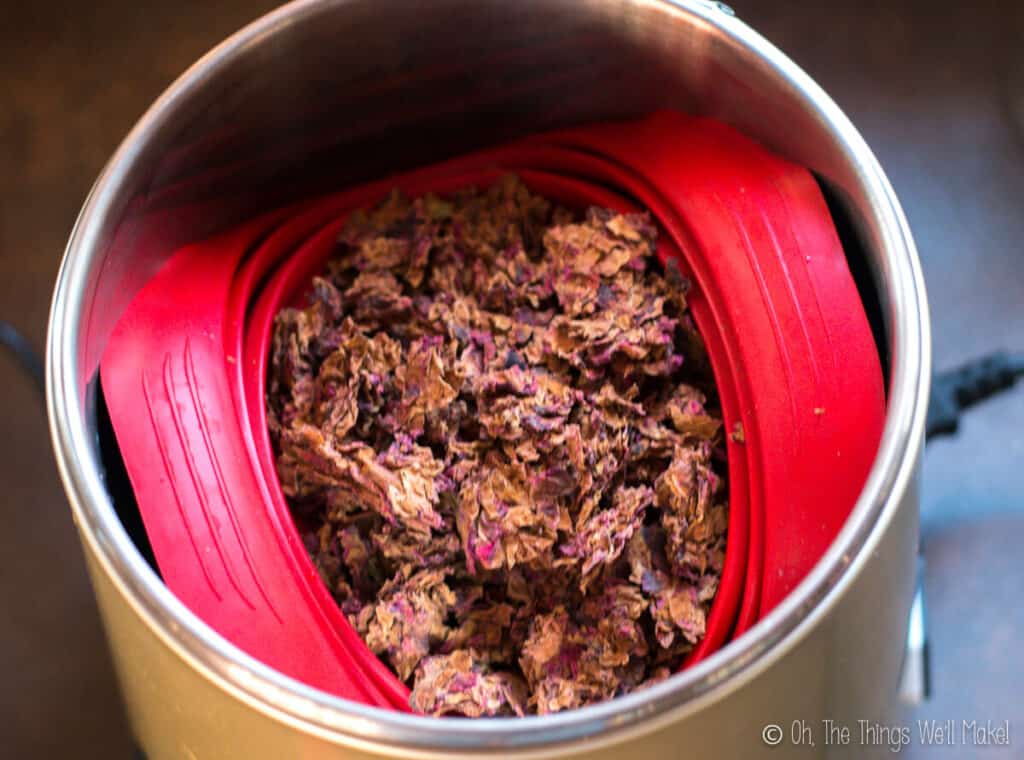
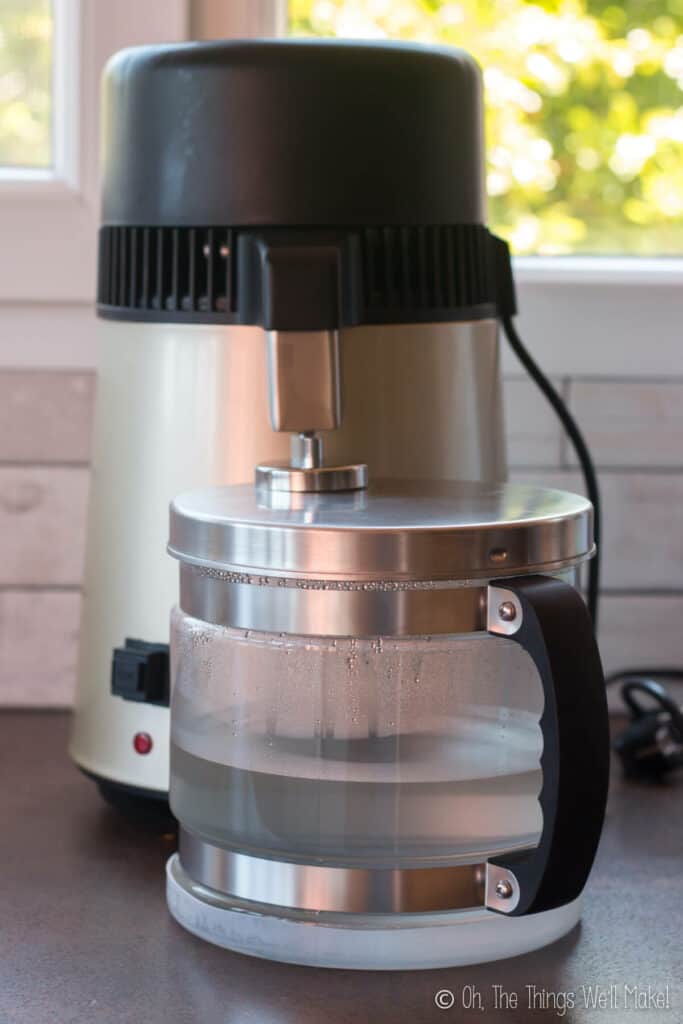
 Rose Petal Bath Bomb Fizzies
Rose Petal Bath Bomb Fizzies
Lynsey
Hi, I was wondering what you do with the remaining water in the pot? Can it be used for anything? Thank you
Lynsey
Tracy Ariza, DDS
Hi Lynsey, most of it gets used up. The very little that remains, I just use it to water my plants. 😉
Meredith
Is it possible to put the rose petals directly into the water in the bottom of my water distilling machine? Is a silicone strainer necessary?
Tracy Ariza, DDS
Hi Meredith,
It’s probably not necessary, but I was doing it to mimic the way distillation is normally done in a still with only the water vapor going through the petals. If you add the petals to the liquid, they make sort of an infusion or tea first- which may or may not matter as it should be distilled anyway.
When I tried making it in a pot, I did see a difference between the batches that had the petals directly in the water and those that didn’t, but it could be from issues with the method used.
lovely
you are so awesome! thank you so much! i use to just boil the water & roses, or infuse water & roses, yet my final product wouldnt mix with my other essential oils or it would smell sour after 4 days 🙁
These preservation tips are wonderful & i can’t wait to try this for my next batch!
Tracy Ariza, DDS
Thanks so much, Lovely!
SIKANDER
BY ADDING POTASSIUM SORBATE AND CITRIC ACID THE SMELL OF ROSEWATER IS CHANGING KINDLY HELP ME OUT OF THIS PROBLEM IF ANY PRESERVATIVE WHICH DO NOT AFFECT THE SMELL OF ROSEWATER THANKS WAITING FOR REPLY
Tracy Ariza, DDS
Hello!
I’ve used some of the different cosmetic preservatives mentioned in my guide to natural preservatives. I just went to smell the ones I have at home right now and have found that while most have mild scents, the mildest one was probably Preservative 1388 ECO.
If you use pre-mixed preservatives, they are generally more effective and can be used in much smaller amounts. In the end, using less of it means that the scent won’t overwhelm in the same way.
Patti
I just discovered your website and am in love with it! I like to formulate my own organic skin care products and find that hydrosols, especially rose hydrosol, can be among the pricier ingredients to purchase. In addition to cost, there is also the added worry of trying to determine whether it is a “true” hydrosol, or just essential oil combined with water and a solubilizer. I finally bit the bullet just before COVID hit and bought a distiller. Best thing ever! I have been making hydrosols like a maniac, not just for skin care, but also for drinking as an alternative to plain water. Love them!
Tracy Ariza, DDS
That’s wonderful! Yes, I bought mine hoping to make essential oils. I don’t really get much oil most of the time, but do like having the hydrosols. 🙂
Claire
Fab article! Going to make rose wster tomorrow. Can you use witch hazel bark and leaves in the stove top method? I was thinking immersing them in water and collecting the hydrosol in the bowl on a rack? Or will it be enough to put them above the water next to the bowl in a steam insert?
Tracy Ariza, DDS
Hi Claire,
Thanks!
I’ve used witch hazel bark in my steam distiller, but I imagine you could use the other methods here for witch hazel too. I think either way would be fine.
Far
I wish you could demonstrate all of these in a video!
Tracy Ariza, DDS
Hi Far,
I can maybe do that. I did take some video of the last time I made the hydrosol in the copper alembic still. It didn’t seem that interesting for a video, but I guess it would be more interesting if I showed the other method too.
Kathryn Turner
Hi Tracey, thank you for your guide. It gave me the confidence to use my still for the first time. I’ve a jar of rose hydrosol in the fridge now!
I noticed some roses were more fragrant than others. And I wondered if the petal oil content rises on a sunny afternoon! Next experiment!!
Waves from Ireland, side eyes at my mint!!
Tracy Ariza, DDS
Hi Kathryn,
Interesting. I don’t know. I do know that some varieties are much more fragrant than others, but didn’t think about the differences that the same rose bush could have.
I’d really love to try this with fresh petals. I’m sure it would make a huge difference.
Brenna
Im wondering how many rose petals to use for the recipe??I’m so excited to try making the hydrosol, thank you for breaking down all the processes!
Tracy Ariza, DDS
Hi Brenna,
I didn’t measure because I fit in as many as I could for each particular method. (So, basically, what fit without soaking in the water below, etc.) The more you use, the more potent you should be able to make it, but don’t feel like you can’t try it if you don’t have a lot of them either. 😉